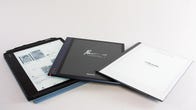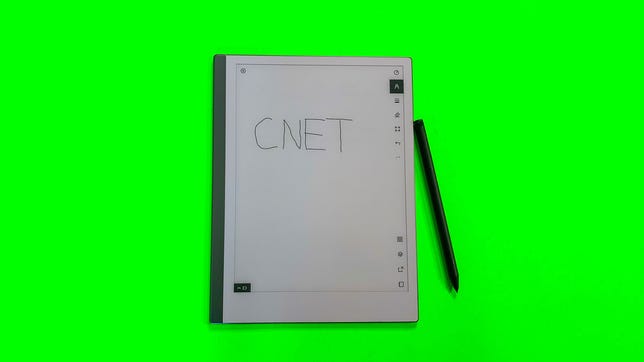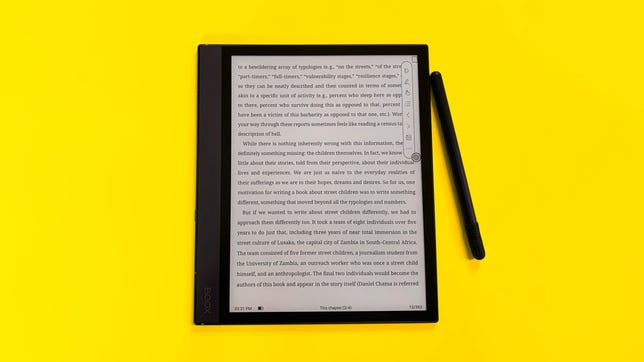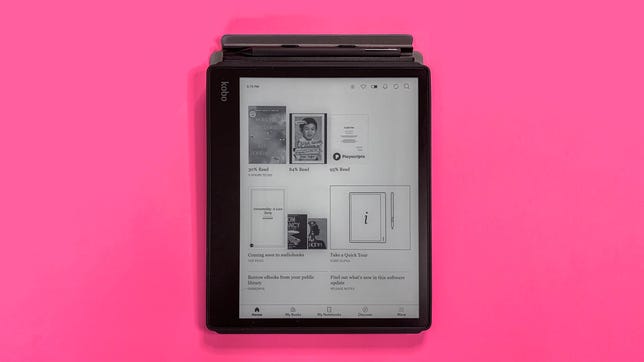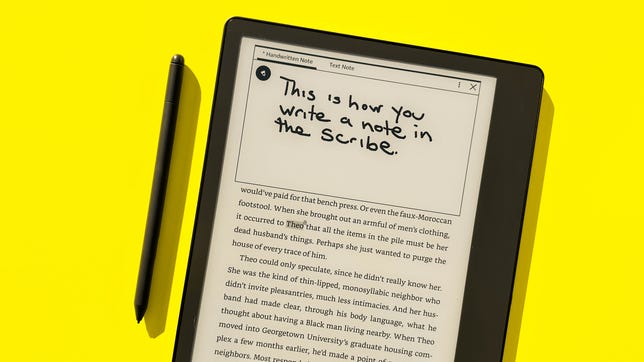In this article:
If you love to write notes by hand, an E Ink tablet could be a good fit. Not only do they provide an excellent reading and writing experience, they also boast a long battery life, while letting you save paper. An E Ink tablet combines the distraction-free and easy-reading environment of a Kindle-style e-reader with the digital handwriting and note-taking ability of a traditional tablet. They eschew the bright LCD displays and superfast processors of Apple, Microsoft, Samsung and Amazon tablets, favoring the efficient gray scale tech.
These devices aren’t going to replace an iPad, though, as they’re mostly just meant for reading and writing. While you won’t be able to stream your favorite show or watch the latest TikTok video on these tablets, you will be able to take them into the classroom without disturbing the professor or your classmates.
I’ve recently spent time with the newest E Ink tablet on the market, the Amazon Kindle Scribe. Like other E Ink tablets on this list, the Kindle Scribe comes with a stylus and offers note-taking and annotation support for PDFs. Additionally, you can take handwritten notes on Kindle titles via a sticky-note application that pins your note to the text. In keeping with Amazon tradition, the Scribe will not directly support ePub files, which means you’ll need to send them to your Kindle via Amazon’s Whispersync service for conversion. The Scribe features a 300-dpi touchscreen and starts at $340 for the 16GB model, though it also comes in 32GB and 64GB versions and is available now.
So how does the new Kindle Scribe compare to other E Ink tablets? Let’s break it down.
Sarah Lord/CNET
The ReMarkable 2 is the best E Ink tablet for students who love to take lots of handwritten notes. It is only 0.19 inch thick and 0.88 pound, which makes it light and easy to carry in your backpack.This 10.3-inch tablet uses a monochrome digital display with a resolution of 226 DPI. The writing and text looks clear and sharp, and you can choose from over 40 different page templates for notes, including seven options just for musical notation. The software is easy to use, with clear buttons at the top for you to add notebooks and folders. It has 8GB of internal storage and now includes handwriting conversion and Google Drive, Dropbox and OneDrive integration. Those services used to be part of ReMarkable’s Connect subscription, but are now included for free with every device. The Connect subscription itself still exists, but now costs $3 a month instead of $8. It offers a ReMarkable 2 protection plan, along with unlimited cloud storage and the ability to add notes in your notebooks when you’re on mobile and desktop devices.
The included stylus doesn’t require pairing or charging but supports tilt detection and a standard 4,096 levels of pressure sensitivity. Practically speaking, it offers the most realistic writing experience of any tablet I’ve ever used. The screen has a paper-like feel, which gives the pen a level of friction that feels incredibly true to life.
The ReMarkable 2 also shines with PDFs. Highlights automatically straighten themselves and turn a legible shade of gray without any needed adjustment. You can add pages to PDFs for extra notes or write in the margins with ease. The ReMarkable’s thinness, two-week battery life, pen input and PDF management capabilities made this E Ink tablet my favorites.
That being said, the ReMarkable 2 isn’t without faults. The biggest issue is that it lacks any kind of backlight, which could be a deal breaker. Much like an actual book or notebook, this device requires an external light source to use in the dark. Even the cheapest Kindle now has front light illumination for night time use. It also doesn’t function particularly well as an e-reader, as the only formats it supports are PDF and unprotected epub. That means that you won’t be able to access your Kindle content or any other epub books with digital rights management software, which includes almost all legally purchasable ebooks on the market.
Ultimately, I found this tablet to be incredibly useful. This is the cheapest E Ink tablet on our list, but it’s still essentially just a PDF and note-taking device.
Sarah Lord/CNET
The Boox Note Air 2 is the most tablet-like E Ink device I tested. This 10.3-inch tablet features a resolution of 227 DPI, runs on a customized version of the Android 11 operating system and even has its own app store, where you can download third-party apps that have been optimized for the device. And yes, while it doesn’t come pre-baked into the system, there is a way to access the full Google Play store – though I wouldn’t recommend it for anything other than downloading an e-reading app, as the Boox still has an E Ink display and isn’t made for games or video. A step-by-step on how to get the Google Play store installed is in this hands-on review of a previous model.
Also, the Boox comes with only 64GB of nonexpandable storage, so you don’t want apps filling up your system. The company does offer 5GB of cloud storage from its own service for free to help transfer documents to the device, though you can also use Dropbox, Evernote and OneNote.
The biggest benefit of the apps store is that you’ll have access to your entire collection of books from your Kindle, Nook and Kobo library. You can also download the Libby app for library books, and Marvel Unlimited users can download the app and read comics, though not in color. The Note Air 2 includes speakers and a microphone, allowing you to listen to audiobooks from Audible or other audiobook apps.
This is a great selling point of the device, but I found the in-app experience to be less than ideal. Many of the features that make the Note Air 2 unique are disabled in third-party apps. For example, you won’t be able to use the pen to take notes or highlights in books on the Kindle app. Instead, you’ll have to type in notes you want to take, like using the app on any other tablet. To write directly onto books, you’ll need to have them in DRM-free ebook format. Luckily, the Boox supports a wide range of formats including PDF, epub, DOC and Mobi.
Note-taking and PDF management are strong on the Note Air 2 but not as seamless as on the ReMarkable 2. Highlights aren’t automatically straightened, and users have to choose the color and width of the marker. The Note Air 2 provides 16 options of grayscale color, but they all look the same on the device, leaving highlights looking dark and messy. The included stylus also features 4,096 levels of pressure sensitivity but lags ever so slightly when writing across the page. On the plus side, you can include audio recordings for more accurate retention. The Note Air 2 also lets you open a PDF and notebook at the same time in a split-screen view, giving you the ability to read and take notes all at once.
Like the Kindle Paperwhite and Oasis, the Boox Note Air 2 comes with a warm and cold front light to help make the screen easier on the eyes and give it a more paper-like look. You can easily adjust both lights with a swipe-down menu. Plus, it also measures its battery life in weeks, not days.
While this tablet is by far the most expensive on our list, it’s also the most versatile of the E Ink tablets and does a lot well but nothing great.
You might see that the company has recently announced a Note Air 2 Plus. I haven’t tried that one, but it’s almost identical to the original Air 2 — just with a bigger battery, which also makes it very slightly heavier.
Sarah Lord/CNET
Kobo might be a smaller company than Amazon, but it’s been making e-readers for just about as long. While Amazon once made a 9.7-inch Kindle, the product never offered natural input with a touchscreen or stylus and was discontinued in 2014. More recently, Kobo was first with a waterproof e-reader, and it’s the first of the major e-reading players to make a 10.3-inch device with a stylus.
Like most Kobos, the Elipsa is an excellent e-reader and offers battery life measured in weeks, depending on use. Unlike Kindles, Kobos have a seemingly limitless ability to customize the reading experience. You can play continuously with margins, line spacing, fonts and font size to get a page that looks exactly how you want to, no matter the size of the screen. The included stylus can be used on any PDF or Kobo ePub, so it works just as well on library books as it does on books from the Kobo store.
Speaking of the library, Kobo is known for its deep integration with the ebook library service OverDrive. You can easily access, browse and download library books directly from your device, so long as your local library uses OverDrive. Borrowing an ebook from the New York Public Library was a seamless experience and one that makes all Kobos a must-have for library lovers.
Unfortunately, the Elipsa’s note-taking capabilities are lacking. There is a noticeable lag when writing with the stylus for any length of time, and the notebook features are fairly basic. Only four templates are available in the basic notebooks and only a single lined template in the advanced notebooks. Advanced notebooks do let you insert drawings, diagrams, math equations and a free-form section, while also offering the ability to convert your handwriting to text. There are only a few pen types to choose from and only five pen brush sizes.
I wasn’t able to use the notebook feature for anything other than the most basic scribbles and wouldn’t recommend it for anything more than that.
The Kobo Elipsa has 32GB of storage, a resolution of 227 DPI and a blue front light, but it lacks the warm light of the Boox. While this E Ink tablet misses the mark on long-from writing, it excels as a large-screen, library-friendly e-reader with the ability to scribble in the margins.
Sarah Lord/CNET
The Kindle Scribe comes with a fantastic 300 ppi, 10.2-inch display that is evenly lit and perfect for large-format reading. The writing experience is also very pleasant and natural, but the Scribe’s software limitations keep this device from soaring.
The Scribe looks and feels like an extra large Kindle Paperwhite or Oasis, though it lacks the physical page-turning buttons of Amazon’s premium e-reader. Words look crisp and clear, while the device itself is fast and responsive.
The Scribe’s notebooks are easy to use, but lacking in features compared to other E Ink Tablets. You can export your notebooks via email, but there’s no Dropbox or any other third-party support. There are 18 notebook templates available, including six lined options, graphing paper, musical notation and to-do lists. All of that is great, but these notebooks lack any smart features. For example, there’s no way to insert equations or convert your handwriting to text.
Similarly, writing in books and documents is too limited to be useful to serious highlighters and doodlers. That’s because Amazon doesn’t actually let you write directly on the page in anything other than a PDF. Instead, you’ll need to write on “sticky notes” if you want to handwrite a note in a book or even a Word Doc. Not only does this prevent you from scribbling in the margins of books, it also means you’ll need to take a separate action to start writing at all.
The sticky notes are then collected automatically in your Notes and Highlights section, where they are presented without any of the context in which you wrote them. It does allow you to jump to the page on which a note was written by tapping on your markings. This is great in theory, but is confusing if you have more than one note on each page, as it doesn’t pinpoint the exact location where the note was created. The Scribe also doesn’t let you write any kind of notes at all on manga, comics, graphic novels, magazines or newspapers.
Currently, you are allowed to write directly on the page in PDFs, but the experience isn’t great. The pen itself works well, but dealing with documents is more difficult than it should be. When you’re in a PDF, you aren’t able to adjust the font size or layout, so instead you have to pinch to zoom in order to enlarge or reposition the document. That part works well, and it’s not too hard to find a level that works best for you. However, once you’re positioned in your PDF, you can’t stay there. The Scribe makes it impossible to maintain your current zoom levels from one page to the next. Instead, you have to zoom all the way out again in order to swipe to the next page, just to reposition it all over again. This is a huge pain and makes reading long PDFs cumbersome and frustrating.
Ultimately, the Scribe is great if you want a large-screen e-reader or are eager to handwrite sticky notes in Amazon books. But it just isn’t quite good enough at either PDFs or in-line note-taking to recommend it as anything other than a gigantic, but excellent, Kindle.
How we test E Ink tablets
Every E Ink tablet undergoes extensive hands-on testing. In this case, each tablet was used for one week of rehearsal in a professional theatrical production. This involved evaluating the set-up process, loading PDFs and books onto the devices, and using both the device and included stylus as a script during full six-hour days of rehearsal. Tasks included highlighting, taking notes in the margins, and creating and taking detailed notes in notebooks. We also downloaded ebooks onto the device and used it as a recreational e-reader.
Anecdotally, we considered the hardware design and features, stylus capabilities, overall ease of use, effective UI layouts, notebook settings, E Ink settings, PDF markup capabilities, e-reading settings and format compatibility, app support and performance, and the overall speed and reliability of the system.
E Ink tablet FAQ
How is an E Ink tablet different from an e-reader?
Both e-readers and E Ink tablets use E Ink technology to render words and images on the page. They both offer a distraction-free experience that’s easier on the eyes than a traditional LCD color screen.
E-readers tend to be smaller than size and focus only on the experience of reading a book or PDF. E Ink tablets offer e-reading features but also include the ability to use a stylus to write notes in a digital notebook and/or in the margins of PDFs and ebooks. Since handwriting is integral to the E Ink tablet experience, the devices themselves tend to be bigger in order to more closely approximate the size of a sheet of paper.
Who are E Ink tablets for?
E Ink tablets are best suited for people who enjoy writing notes or sketching by hand and who need to read and markup lots of PDF or DRM-free ebooks. They could be a particularly good fit for students, lawyers or any other professional in need of a digital, distraction-free note-taking device.
They aren’t for people who want constant notifications, fast processing speeds, to watch videos or play games.

